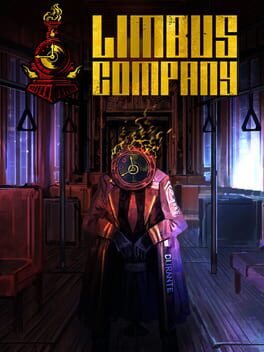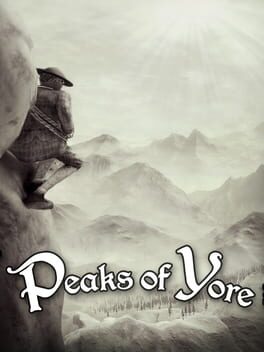Plandiss
Bio
I make video reviews on games.
Favorite genres are Action RPGs, Precision Platformers, and Turn-Based Tactics.
Used to be a hardcore gamer.
I make video reviews on games.
Favorite genres are Action RPGs, Precision Platformers, and Turn-Based Tactics.
Used to be a hardcore gamer.
Badges

Listed
Created 10+ public lists

Gone Gold
Received 5+ likes on a review while featured on the front page

GOTY '23
Participated in the 2023 Game of the Year Event

Liked
Gained 10+ total review likes

Best Friends
Become mutual friends with at least 3 others

Noticed
Gained 3+ followers

Organized
Created a list folder with 5+ lists

Roadtrip
Voted for at least 3 features on the roadmap

N00b
Played 100+ games
Favorite Games
221
Total Games Played
020
Played in 2024
584
Games Backloggd
Recently Played See More
Recently Reviewed See More
Pseudoregalia has pretty good movement huh? Too bad that's about the most it has going for it! While Pseudoregalia is a decently fun ride, most of that time is spent meandering through environments that are just similar enough to each other to make it easy to get lost, but just distinct enough where you wouldn't call it same-y.
Combat is very bland and boring, you start the game with a three-strike combo with very wonky hitboxes and you end the game with the exact same thing. Your dodge barely functions as a dodge since it's just a slide (I cannot tell if it even has I-frames or not) and the enemy variety is so sparse that avoiding combat is more fun than being in it.
To be fair though, the game's graphical style has quite a bit of charm. And the music also adds to make a much richer experience. In general, I am a complete sucker for the PS1-PS2 style of graphics and models. Pseudoregalia fits in this and definitely jumps out as a game that feels like it was released over twenty years ago when in reality it's a 2023 baby. That's a good thing, I like that.
Now, the movement. I think it's pretty good. There's a lot of hidden tech and as you continue to increase your arsenal it builds into a system that you weave quite naturally and feels very good. The air kick is very interesting and unique when it comes to movement systems, giving you the ability to kick off walls a limited amount of times and into the direction that you are trying to move towards. It gives the power of wall jump without letting it be infinite and making it feel more like a natural part of the kit. The ground pound jump, long jump, basically all the things you can think of from Mario 64 are here plus more. The best part is it all comes without the baggage of Mario 64's clunk! Moving Sybil around without any of the upgrades feels smooth and player-friendly. However, if you don't get those upgrades, it definitely feels like there is something missing. Without the map that was recently added, it is very easy to get lost and filtered before reaching your first movement ability. I know I did at first! But if you can get past that initial chunk where you feel pretty lacking, the movement does become something pretty special. Unfortunately, I think the movement would be better in a different kind of game, but I digress.
Lastly, the story. In stereotypical metroidvania fashion, the story is very sparse and you have to look for it. Unfortunately, Pseudoregalia is pretty short so the story has no time to flourish, and none of the flavor text really does much to give you much of a story. All the story you get is after you reach the final area of the game, where you can somewhat gleam hints at a story, but not much else. In that regard, it makes the journey of exploring the castle kind of forgettable. There isn't really a motivator to keep going or keep doing things outside of the idea that you are playing a game and games are fun. It doesn't bother me when a game's story is complicated or secretive, but it does bother me when there is basically no story at all. Unless you want your gameplay to speak for itself, most games need some main motivator, and Pseudoregalia just does not have one.
Pseudoregalia is a fun but jumbled mess. Most of the game feels clambered together without a good enough rhyme or reason. I understand the idea was to make a dreamy, aetheric atmosphere, but I think it fundamentally failed at hitting those notes when I struggled to discern the differences between each area. Nothing felt coherent outside of the movement, which while really good, could've been better in another game. Though for a solo dev, this is quite impressive, so I still look forward to what they do next.
Combat is very bland and boring, you start the game with a three-strike combo with very wonky hitboxes and you end the game with the exact same thing. Your dodge barely functions as a dodge since it's just a slide (I cannot tell if it even has I-frames or not) and the enemy variety is so sparse that avoiding combat is more fun than being in it.
To be fair though, the game's graphical style has quite a bit of charm. And the music also adds to make a much richer experience. In general, I am a complete sucker for the PS1-PS2 style of graphics and models. Pseudoregalia fits in this and definitely jumps out as a game that feels like it was released over twenty years ago when in reality it's a 2023 baby. That's a good thing, I like that.
Now, the movement. I think it's pretty good. There's a lot of hidden tech and as you continue to increase your arsenal it builds into a system that you weave quite naturally and feels very good. The air kick is very interesting and unique when it comes to movement systems, giving you the ability to kick off walls a limited amount of times and into the direction that you are trying to move towards. It gives the power of wall jump without letting it be infinite and making it feel more like a natural part of the kit. The ground pound jump, long jump, basically all the things you can think of from Mario 64 are here plus more. The best part is it all comes without the baggage of Mario 64's clunk! Moving Sybil around without any of the upgrades feels smooth and player-friendly. However, if you don't get those upgrades, it definitely feels like there is something missing. Without the map that was recently added, it is very easy to get lost and filtered before reaching your first movement ability. I know I did at first! But if you can get past that initial chunk where you feel pretty lacking, the movement does become something pretty special. Unfortunately, I think the movement would be better in a different kind of game, but I digress.
Lastly, the story. In stereotypical metroidvania fashion, the story is very sparse and you have to look for it. Unfortunately, Pseudoregalia is pretty short so the story has no time to flourish, and none of the flavor text really does much to give you much of a story. All the story you get is after you reach the final area of the game, where you can somewhat gleam hints at a story, but not much else. In that regard, it makes the journey of exploring the castle kind of forgettable. There isn't really a motivator to keep going or keep doing things outside of the idea that you are playing a game and games are fun. It doesn't bother me when a game's story is complicated or secretive, but it does bother me when there is basically no story at all. Unless you want your gameplay to speak for itself, most games need some main motivator, and Pseudoregalia just does not have one.
Pseudoregalia is a fun but jumbled mess. Most of the game feels clambered together without a good enough rhyme or reason. I understand the idea was to make a dreamy, aetheric atmosphere, but I think it fundamentally failed at hitting those notes when I struggled to discern the differences between each area. Nothing felt coherent outside of the movement, which while really good, could've been better in another game. Though for a solo dev, this is quite impressive, so I still look forward to what they do next.
Once again, I find myself trapped in the writer’s room. I must’ve not fit all the pieces together. Something must not have been said correctly. I have to keep trying, keep writing, find my way out of here. Let’s start a new draft.
Alan Wake II is the kind of game that happens when you take developers at the peak of their expertise and give them the budget to create a unique, Triple-A quality action game. Except, except… no, that’s not right. Let’s try that again.
Alan Wake II is an artist’s nightmare. A developer commentary on art and the act of creating it. A work that faces the player in the eye and asks them how they wish to perceive the art they interact with. A game that gives as many different takes on art as there is art in the game. But, wait no…I’m still missing something… it’s not enough. One more time.
Alan Wake II is a mixed media project that combines books, games, film, music, and more. It’s an eclectic piece that uses its multi-faceted variety of displays to create an enriching experience that asks you to keep paying attention. Every little nook and cranny, filled with detail that if missed, could blow the door wide open…. No, NO, NO! This still isn’t right! I have to start further back, before any of this. Before I woke up.
It’s not a lake. It’s an ocean.
To unravel the sheer scope of Alan Wake II, one must be willing to grasp the idea that Alan Wake II is all of these things and more all at once. A mixed media project, an artist's nightmare, a Triple-A action game. I can think of three moments in this game that poignantly blew my mind out the back of my skull like a cannon, all from sheer awe. Alan Wake II is a Resident Evil-Metal Gear Solid-Undertale-like. It exists in a space where it is all of these games and none of these games at the same time. I... honestly, I really don't know if I can find the words to describe just how unique and bizarre and interesting and fun this game is.
Let's start with the combat. Alan Wake II is a survival horror game with a specific focus on "light-based combat". Limited resources, limited inventory space, and a focus on making your shit count are the staples of combat. The light is what makes it a little more unique. To make an enemy vulnerable to damage, you must first shine a light on them of extreme strength. The base method is using your flashlight which has a limited amount of charges per battery, four to start. After you've made them vulnerable you can begin to attack, but if you stay disengaged for long enough or hide yourself within a light source, the enemies may regain this "darkness" to hide from your damage. And those light sources make you completely invisible to enemies, but most are temporary meaning you can't abuse them to take out enemies. And even in the permanent light of safe rooms, the enemies can't be taken out. This focus on light is a huge part of the game, both gameplay-wise and narratively. However, it also presents one of my two gripes, most of the time it is simply better to avoid enemies rather than fighting them not because you lack ammo, but batteries. Light is used for much more than just making enemies temporarily vulnerable, it can also open up pathways, or destroy projectiles. It's a necessity to stay alive and to continue moving forward. To some this may be an interesting conundrum to face, very typical survival horror decision-making. Yet, in my experience, it took out the decision-making entirely. My playstyle entirely depended on whether or not the game had decided to give me enough batteries to engage or not. However, that didn't stop the combat at its best moments from providing genuine thrills comparable to the best in the genre. Some arenas for fighting weren't perfect, and clarity was a bit of an issue at times for projectiles, but otherwise....well, let's just say the Old Gods of Asgard would be proud.
Alan Wake II is split into two different sections divided by the two separate protagonists: Alan Wake and Saga Anderson. Our dual protagonists are separated by their differing realities, those being the real world and the Dark Place. After playing through the respective prologues you gain access to switch between the two freely. A good way of playing through the game is to play a chapter then switch and do the other person's chapter over and over, starting with Alan. ...but, you could do any other order you want. Unfortunately, I think that's not necessarily for the best. Allowing the player to choose their pacing sounds smart in theory, but it creates more problems than anything since you don't know in advance just how long a chapter is, what kind of sections take place in it, etc. Some chapters are finishable within 30 minutes while others last up to 3 hours. You simply can't predict which it will be, and theoretically you could also just focus on one character or the other, royally breaking the pace of the story. The worst part is that I wouldn't even blame you if you DID choose to play one character over the other! The distinct difference in locals between the characters offers unique thrills to each, but one is definitely more inherently interesting.
The Dark Place is a fascinating place. In both story and game design, it is a vastly more unique setting from its real world counterpart. Non-Euclidean geometry, self-referential art design, and consistent fourth wall breaking to the point you might question if there was a fifth wall. The majority of the game's meta-commentary on the act of creating art happens here. That on top of the writing for most of the commentary from Alan Wake is written like it was written for the book that he is currently writing to get out of the Dark Place. The Dark Place and its existence, Alan Wake's place there, and how the world bends around you are all very convoluted, confusing, and difficult to understand. That's what makes it so much more rewarding to participate in. On top of this, the Dark Place contains a majority of the live-action cutscenes in the game. These live-action segments are incredibly interesting from both a game perspective and a story perspective. Not only do they continue to push the boundaries between character, player, and creator, but they push the surrealism even higher than before. All of this culminates into an experience that leads one wanting, no, craving more of this dreamscape.
Each character has a specific mechanic tied to them that relates to progression and both are subverting in an interesting way narratively later on. For Saga, she has her "Mind Place" where as she talks to people and sees clues, she can fit the pieces together in her head and discover the truth around matters. This narratively allows the player an easy way to check the flow of the plot without being overbearing AND giving details about where we are going without coming off as obtrusive. On the other hand, Alan has the "Writer's Room", where he can transform areas of the Dark Place to match with certain themes that he finds throughout his journey. This feeds back into the ever-changing distressfully dream-like structure of the Dark Place and makes progressing with Alan simple and understandable. If you find a new theme, you know to try and attach it to the different locations to see what fits. And if you haven't found all the locations, you know you have to better utilize your themes. This combined with Alan's lamp that can give and take light sources creates an interesting exploration feedback loop that builds up the mystique while slowly letting you piece together the puzzle that is the environment you reside in. I won't say how all of these mechanics fit together in the grand scheme narratively but note that how they manage it feels incredibly earned and something I adore. I love taking gameplay mechanics and making them feel real within the world, rather than made-up gamey bullshit. Alan Wake manages to play into this gamey bullshit and makes such a GAMEY game that no matter how much stuff is happening and no matter how crazy it is...it just feels right.
MINOR SPOILERS AHEAD
This leads to my three big moments. Two of those moments are ones that just about everyone raves about already. The Dark Ocean Summoning and the Herald of Darkness. Yet, more poignant than these two grandiose moments, is one quiet moment near the end of Alan's half of the game. A moment that completely caught me off-guard and remains one of my favorite moments in a game full of surprising and incredibly interesting moments. A game full of meta-commentary on creating art and the struggles of it, nothing sticks out more than after you make it through the theater. You spend a lot of time exploring this area and progressing through it like all the others, and after you finish it, you begin to walk out and continue progressing. Except, on the theater screen...it begins to play a short film. It starts with a small excerpt in Finnish, then the title: Nightless Nights. For the next fifteen minutes, I sat there just... entranced. Something about that experience. I, sitting on my couch, playing a game as Alan Wake, who stood in a movie theater, watching a short film where the creative director of the game I was playing played a fictional character in the fictional story of the writer Alan Wake. The complete surreality of both the experience and the short film itself... was truly magical. I felt like I was looking directly into the vision of the developer, the vision for this art, the vision of the vision. It's not a lake, it's an ocean.
Alan Wake II is truly a one-of-a-kind interactive experience. It's simultaneously one of the most creepy horror games I have played, a fascinating deep dive into what it's like to try and make something for people and the aftermath if it succeeds, and an exceptionally creative art project involving the full minds of so many incredibly talented people. It's a game that if you love games, love writing, love art, love creating things, you will get so much out of. Alan Wake II is as much a game about a game as it is a movie about a narrative, a song about a character, a game about a book. Yet, even still I don't know if I found the right words to properly describe it. Is this truly the best ending I could find? Let's try this again.
It's not a loop, it's a spiral.
Alan Wake II is the kind of game that happens when you take developers at the peak of their expertise and give them the budget to create a unique, Triple-A quality action game. Except, except… no, that’s not right. Let’s try that again.
Alan Wake II is an artist’s nightmare. A developer commentary on art and the act of creating it. A work that faces the player in the eye and asks them how they wish to perceive the art they interact with. A game that gives as many different takes on art as there is art in the game. But, wait no…I’m still missing something… it’s not enough. One more time.
Alan Wake II is a mixed media project that combines books, games, film, music, and more. It’s an eclectic piece that uses its multi-faceted variety of displays to create an enriching experience that asks you to keep paying attention. Every little nook and cranny, filled with detail that if missed, could blow the door wide open…. No, NO, NO! This still isn’t right! I have to start further back, before any of this. Before I woke up.
It’s not a lake. It’s an ocean.
To unravel the sheer scope of Alan Wake II, one must be willing to grasp the idea that Alan Wake II is all of these things and more all at once. A mixed media project, an artist's nightmare, a Triple-A action game. I can think of three moments in this game that poignantly blew my mind out the back of my skull like a cannon, all from sheer awe. Alan Wake II is a Resident Evil-Metal Gear Solid-Undertale-like. It exists in a space where it is all of these games and none of these games at the same time. I... honestly, I really don't know if I can find the words to describe just how unique and bizarre and interesting and fun this game is.
Let's start with the combat. Alan Wake II is a survival horror game with a specific focus on "light-based combat". Limited resources, limited inventory space, and a focus on making your shit count are the staples of combat. The light is what makes it a little more unique. To make an enemy vulnerable to damage, you must first shine a light on them of extreme strength. The base method is using your flashlight which has a limited amount of charges per battery, four to start. After you've made them vulnerable you can begin to attack, but if you stay disengaged for long enough or hide yourself within a light source, the enemies may regain this "darkness" to hide from your damage. And those light sources make you completely invisible to enemies, but most are temporary meaning you can't abuse them to take out enemies. And even in the permanent light of safe rooms, the enemies can't be taken out. This focus on light is a huge part of the game, both gameplay-wise and narratively. However, it also presents one of my two gripes, most of the time it is simply better to avoid enemies rather than fighting them not because you lack ammo, but batteries. Light is used for much more than just making enemies temporarily vulnerable, it can also open up pathways, or destroy projectiles. It's a necessity to stay alive and to continue moving forward. To some this may be an interesting conundrum to face, very typical survival horror decision-making. Yet, in my experience, it took out the decision-making entirely. My playstyle entirely depended on whether or not the game had decided to give me enough batteries to engage or not. However, that didn't stop the combat at its best moments from providing genuine thrills comparable to the best in the genre. Some arenas for fighting weren't perfect, and clarity was a bit of an issue at times for projectiles, but otherwise....well, let's just say the Old Gods of Asgard would be proud.
Alan Wake II is split into two different sections divided by the two separate protagonists: Alan Wake and Saga Anderson. Our dual protagonists are separated by their differing realities, those being the real world and the Dark Place. After playing through the respective prologues you gain access to switch between the two freely. A good way of playing through the game is to play a chapter then switch and do the other person's chapter over and over, starting with Alan. ...but, you could do any other order you want. Unfortunately, I think that's not necessarily for the best. Allowing the player to choose their pacing sounds smart in theory, but it creates more problems than anything since you don't know in advance just how long a chapter is, what kind of sections take place in it, etc. Some chapters are finishable within 30 minutes while others last up to 3 hours. You simply can't predict which it will be, and theoretically you could also just focus on one character or the other, royally breaking the pace of the story. The worst part is that I wouldn't even blame you if you DID choose to play one character over the other! The distinct difference in locals between the characters offers unique thrills to each, but one is definitely more inherently interesting.
The Dark Place is a fascinating place. In both story and game design, it is a vastly more unique setting from its real world counterpart. Non-Euclidean geometry, self-referential art design, and consistent fourth wall breaking to the point you might question if there was a fifth wall. The majority of the game's meta-commentary on the act of creating art happens here. That on top of the writing for most of the commentary from Alan Wake is written like it was written for the book that he is currently writing to get out of the Dark Place. The Dark Place and its existence, Alan Wake's place there, and how the world bends around you are all very convoluted, confusing, and difficult to understand. That's what makes it so much more rewarding to participate in. On top of this, the Dark Place contains a majority of the live-action cutscenes in the game. These live-action segments are incredibly interesting from both a game perspective and a story perspective. Not only do they continue to push the boundaries between character, player, and creator, but they push the surrealism even higher than before. All of this culminates into an experience that leads one wanting, no, craving more of this dreamscape.
Each character has a specific mechanic tied to them that relates to progression and both are subverting in an interesting way narratively later on. For Saga, she has her "Mind Place" where as she talks to people and sees clues, she can fit the pieces together in her head and discover the truth around matters. This narratively allows the player an easy way to check the flow of the plot without being overbearing AND giving details about where we are going without coming off as obtrusive. On the other hand, Alan has the "Writer's Room", where he can transform areas of the Dark Place to match with certain themes that he finds throughout his journey. This feeds back into the ever-changing distressfully dream-like structure of the Dark Place and makes progressing with Alan simple and understandable. If you find a new theme, you know to try and attach it to the different locations to see what fits. And if you haven't found all the locations, you know you have to better utilize your themes. This combined with Alan's lamp that can give and take light sources creates an interesting exploration feedback loop that builds up the mystique while slowly letting you piece together the puzzle that is the environment you reside in. I won't say how all of these mechanics fit together in the grand scheme narratively but note that how they manage it feels incredibly earned and something I adore. I love taking gameplay mechanics and making them feel real within the world, rather than made-up gamey bullshit. Alan Wake manages to play into this gamey bullshit and makes such a GAMEY game that no matter how much stuff is happening and no matter how crazy it is...it just feels right.
MINOR SPOILERS AHEAD
This leads to my three big moments. Two of those moments are ones that just about everyone raves about already. The Dark Ocean Summoning and the Herald of Darkness. Yet, more poignant than these two grandiose moments, is one quiet moment near the end of Alan's half of the game. A moment that completely caught me off-guard and remains one of my favorite moments in a game full of surprising and incredibly interesting moments. A game full of meta-commentary on creating art and the struggles of it, nothing sticks out more than after you make it through the theater. You spend a lot of time exploring this area and progressing through it like all the others, and after you finish it, you begin to walk out and continue progressing. Except, on the theater screen...it begins to play a short film. It starts with a small excerpt in Finnish, then the title: Nightless Nights. For the next fifteen minutes, I sat there just... entranced. Something about that experience. I, sitting on my couch, playing a game as Alan Wake, who stood in a movie theater, watching a short film where the creative director of the game I was playing played a fictional character in the fictional story of the writer Alan Wake. The complete surreality of both the experience and the short film itself... was truly magical. I felt like I was looking directly into the vision of the developer, the vision for this art, the vision of the vision. It's not a lake, it's an ocean.
Alan Wake II is truly a one-of-a-kind interactive experience. It's simultaneously one of the most creepy horror games I have played, a fascinating deep dive into what it's like to try and make something for people and the aftermath if it succeeds, and an exceptionally creative art project involving the full minds of so many incredibly talented people. It's a game that if you love games, love writing, love art, love creating things, you will get so much out of. Alan Wake II is as much a game about a game as it is a movie about a narrative, a song about a character, a game about a book. Yet, even still I don't know if I found the right words to properly describe it. Is this truly the best ending I could find? Let's try this again.
It's not a loop, it's a spiral.
Peaks of Yore is the best climbing game to date. With exceptionally fun mechanics, intuitive controls (unlike most other climbing games), a plethora of unique and interesting mountains to climb, and a reward structure that keeps the player wanting to play more, Yore stands alone at what might be the peak of this genre.
The only disappointing part of the game is the fact that to beat the game, you don't even have to do every mountain.
The only disappointing part of the game is the fact that to beat the game, you don't even have to do every mountain.












